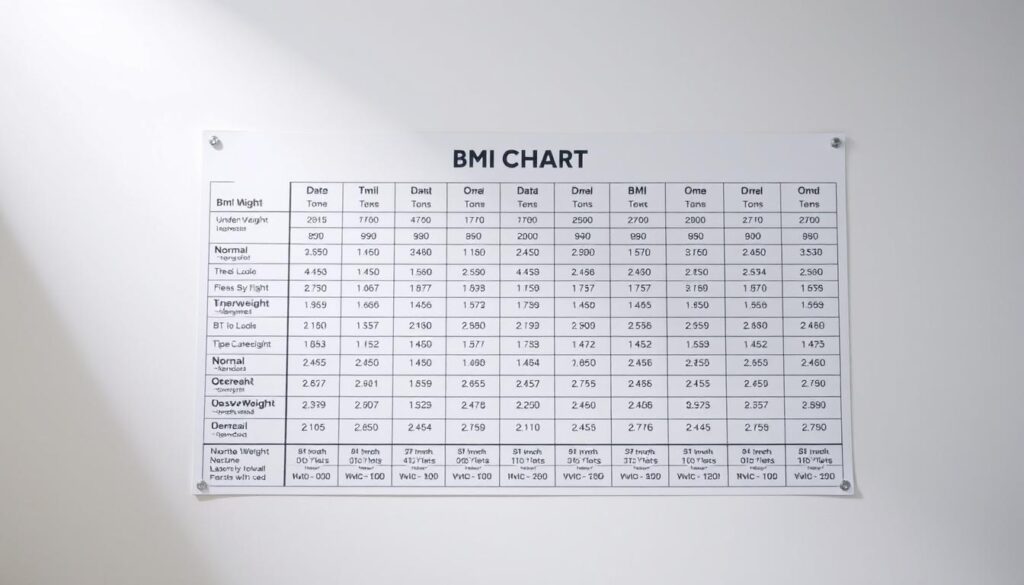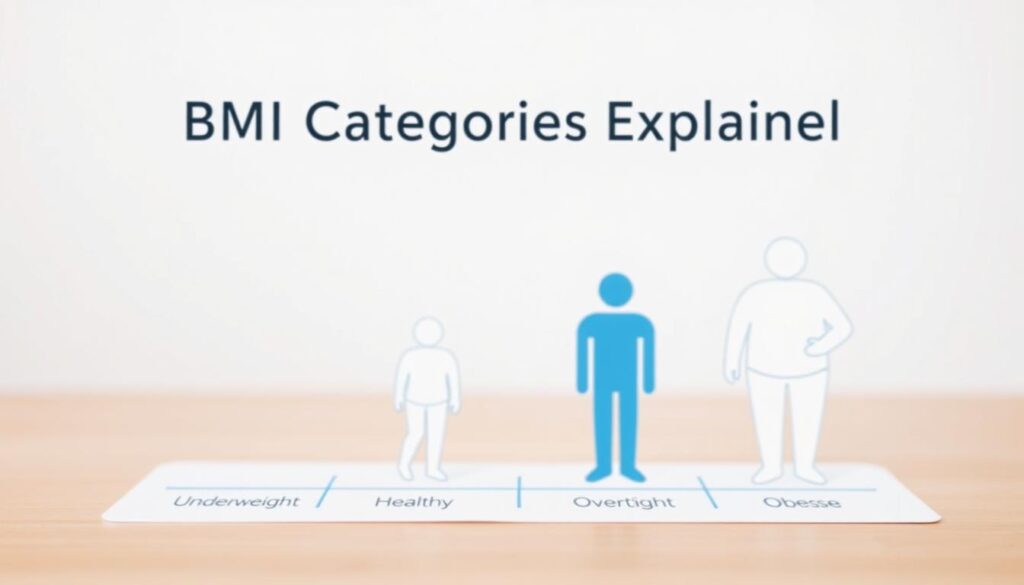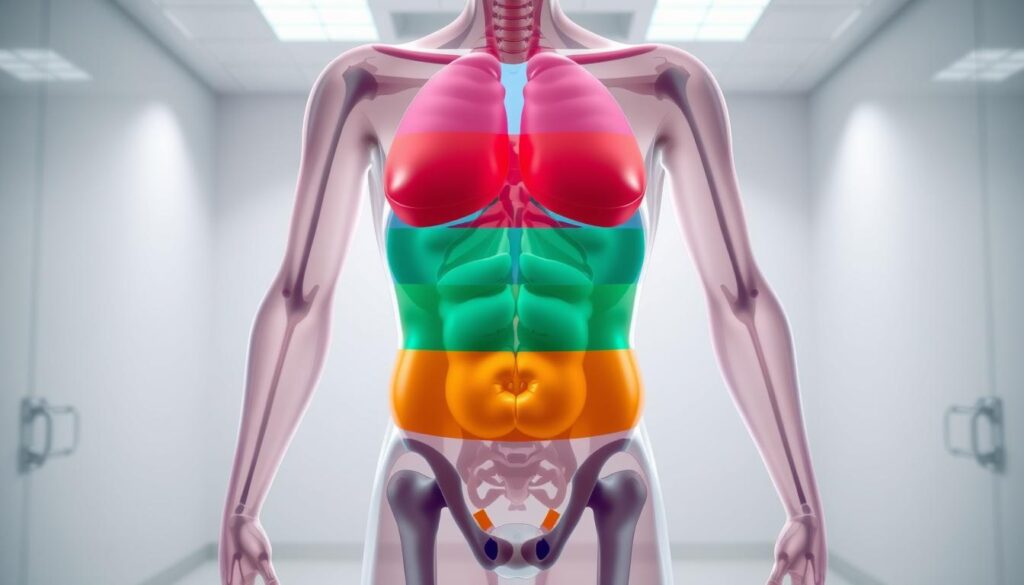Do you know the threshold for obesity based on Body Mass Index (BMI)? It’s key to know this to understand health risks tied to weight.
The Centers for Disease Control and Prevention say a BMI of 30 or more is obese. You can use a BMI calculator to find out your BMI and see where you stand.
Let’s dive into BMI categories: underweight (below 18.5), normal (18.5-24.9), overweight (25.0-29.9), and obesity (30.0 and above). For more on obesity’s health risks, check out the National Heart, Lung, and Blood Institute website.
Key Takeaways
- Obesity is defined as a BMI of 30 or higher.
- Understanding BMI categories is crucial for assessing health risks.
- A BMI calculator can help determine your weight status.
- Obesity is associated with various health risks.
- Maintaining a healthy weight is vital for overall well-being.
Understanding BMI and Its Importance
Body Mass Index (BMI) is key to checking our health. It’s a common way to see if our weight is healthy for our height.
What is Body Mass Index (BMI)?
BMI is a simple way to figure out body fat based on height and weight. Doctors use it to see if our weight is healthy.
BMI Categories sort people into weight groups. These groups are underweight, normal, overweight, and obese. They show health risks tied to body fat levels.
How is BMI Calculated?
To find BMI, divide weight in kilograms by height in meters squared (kg/m2). For example, a 70 kg person who is 1.75 meters tall has a BMI of 22.86.
There are BMI charts for obesity and calculators. They make finding your BMI easy and quick.

Why is BMI Used as a Health Indicator?
BMI shows if a person’s weight is healthy for their height. It spots health risks from being underweight, overweight, or obese. High BMI can mean higher risks of diabetes, heart disease, and some cancers.
- Assesses weight status
- Helps identify potential health risks
- Provides a simple and cost-effective way to screen for obesity and related health issues
Even with its limits, BMI is still useful in health care. It helps with calculating BMI for obesity and understanding health risks.
BMI Categories Explained
It’s important to know the Body Mass Index (BMI) categories. They help us understand our health status. BMI categories show us where we stand in terms of weight and health risks.

Underweight: A Closer Look
Being underweight means your BMI is less than 18.5. This can lead to nutrient deficiencies and fatigue. If you’re underweight, talking to a doctor is key. They can help find the cause and guide you to a healthier weight.
Normal Weight: What Does it Mean?
A normal weight is a BMI of 18.5 to 24.9. People in this range face fewer health risks. Eating well and staying active can help keep you healthy.
Overweight vs. Obesity: Key Differences
The World Health Organization says being overweight is a BMI of 25-29.9. Obesity is a BMI of 30 or higher. Obesity carries a higher risk of diseases like diabetes and heart disease. Knowing the difference helps in fighting these conditions.
Understanding BMI categories helps us work towards a healthy weight. This reduces the chance of health problems.
Obesity: Identification and Implications
Understanding obesity starts with knowing how BMI defines it. Obesity is a serious condition with too much body fat. BMI helps identify those at risk.
Obese BMI Range
A BMI of 30 or higher is considered obese. The CDC says this means obesity, divided into three classes. Class 1 is 30-34.9, Class 2 is 35-39.9, and Class 3 is 40 or higher. Knowing these classes helps understand obesity’s severity and health risks.

Health Risks Associated with Obesity
Obesity is linked to many serious health issues. The American Cancer Society says it raises cancer risks, including breast, colon, and kidney cancer. It also increases risks for heart disease, type 2 diabetes, and musculoskeletal disorders. These risks show why managing and preventing obesity is crucial.
- Cardiovascular diseases
- Type 2 diabetes
- Certain types of cancer (breast, colon, kidney)
- Musculoskeletal disorders
The Emotional and Social Impact of Obesity
Obesity affects not just physical health but also emotions and social life. People with obesity face stigma, discrimination, and mental health issues like depression and anxiety. This shows why treating obesity needs a holistic approach, including mental support and social understanding.
We must see obesity’s full impact and work towards supportive environments. These should encourage healthy lifestyles and offer needed support for those dealing with obesity.
Visual Representation of BMI Data
To grasp the impact of obesity, we can use visual aids. Infographics make complex data simple and clear. They help us understand better.
BMI Categories Overview
An infographic can show BMI categories quickly and clearly. It breaks down BMI into underweight, normal weight, overweight, and obese. Knowing these categories helps spot health risks.
Health Risks of Obesity
Obesity brings many health dangers, like diabetes, heart disease, and some cancers. The Centers for Disease Control and Prevention share detailed data. They stress the need for a healthy weight.
| Health Risk | Description |
|---|---|
| Diabetes | Increased risk of developing type 2 diabetes due to insulin resistance. |
| Heart Disease | Obesity can lead to high blood pressure and cholesterol levels, increasing the risk of heart disease. |
| Cancer | Certain types of cancer, such as breast, colon, and kidney cancer, have been linked to obesity. |
Visualizing BMI data and health risks helps us see why preventing obesity is key. This way of showing information boosts understanding. It also motivates us to take care of our health.
Steps to Manage and Reduce Obesity
Managing and reducing obesity needs a full plan. This includes lifestyle changes, expert advice, and staying committed for a long time. First, knowing your BMI is key. It shows if you’re underweight, normal, overweight, or obese. Obese is 30 or higher.
Understanding your BMI helps a lot.
Lifestyle Changes: The First Steps
Start by making healthier choices. Eat well and exercise often. Losing 5-10% of your weight can lower health risks a lot. This is what the American Cancer Society says.
Seeking Professional Help: When to Consult a Doctor
Getting help from a doctor is often a good idea. They can give you specific advice based on your BMI. This helps you understand your weight range and plan a weight loss strategy.
Long-term Strategies for Maintenance and Success
Keeping up with healthy habits is key to success. Regularly check your BMI to track your progress. Making changes as needed helps keep your weight loss going and improves your health.


